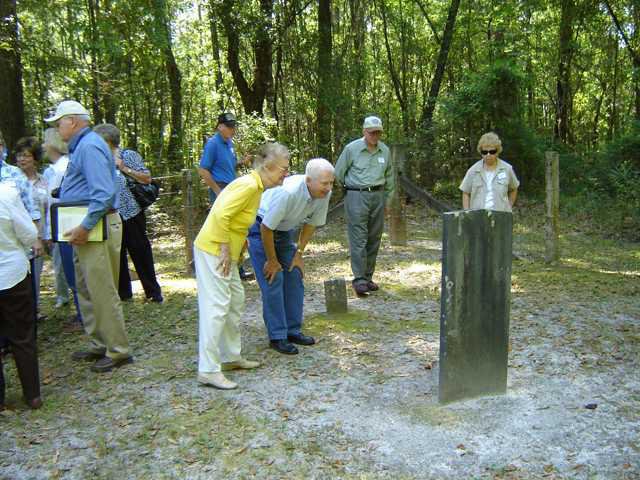When wartime came to 1940s Georgia, rural life was turned on its ear for the residents of Taylors Creek and other small communities scattered throughout nearly 300,000 acres. The Department of Defense needed their land for a strategic military post and they could do nothing more than take what little money was offered and move out to make a new life somewhere else.
Today, Fort Stewart shows its appreciation for the tremendous sacrifice of these citizens by preserving their cemeteries, which are scattered throughout the installation, and welcoming their descendants on tours to relive history and remember loved ones.
About 50 people, including many descendants, joined Fort Stewart Public Affairs Officer Pat Young on a tour Wednesday, tolerating the heat and bumpy ride through wooded training areas to view gravestones and remark on the life they and their parents, grandparents and others once lived.
“In 1941, the government purchased all the properties. The families didn’t really have much choice in the matter, and many had to pack up within a day or two. There was even a case of an individual being carried out,” Young said.
In most cases, if not all, the land was purchased for less than its value. Young said the entire Pleasant Grove community, for example, was bought for about $2,000. After World War II many families thought they would get their land back, but the onset of the Cold War and the Cuban Missile Crisis banished those hopes.
More than 50 cemeteries are believed to be scattered throughout the installation, Young said. The largest of these is the Taylors Creek Cemetery. Brothers James and William Taylor obtained land grants along the creek banks in 1760. The Methodist church was established in1807 and around it the community of Taylors Creek grew.
Local historian and Taylors Creek resident Wyman May treated tour guests to brief histories of the families resting in the cemeteries. May was instrumental in the creation of a book on the history of Taylors Creek and has documented the cemeteries on the installation. He, along with several tour guests, are members of the Taylors Creek Cemetery Association.
May’s own memory was jogged and the crowd was treated to an amusing story when a tour guest, Betty Davis, told a story of being chased in the school yard at Taylors Creek by May and another boy.
“One day at recess, he and Earl Phillips were gonna chase me. They did that every day, but they didn’t catch me. But that day, there was something on the ground and I stubbed my toe and went right down on the ground. You gave me a kiss on this side and he gave me a kiss on that side, and then I turned around and I slapped him and I slapped you,” Davis said to a roar of laughter from the crowd.
Greg Harvey, chief of conservation law enforcement, has been escorting visitors on cemetery tours for 21 years. He also has a deep personal connection to the long-ago community — his family lost two farms in the wartime acquisition. “My grandfather, Linton, owned 265 acres on one tract and 184 acres on another tract.”
Though in later years his ancestors would view their loss as a sacrifice for a greater cause, Harvey said having to move was painful for his family. “They didn’t want to leave,” he said.
James Baker of Midway was a first-timer on the tour. The longtime resident and Air Force veteran said he enjoyed learning about the local history and said he hopes future trips will include tours of post facilities like motorpools and the electronic skills trainer, where soldiers practice marksmanship. Young told tour guests these locations as well as the Fort Stewart Museum could be added to future trips.
As Young stressed the post’s determination to continue its outreach efforts today, he reminded tour guests of the opportunities on post that they can take part in as area residents. Bowling, roller skating, golf, post religious services and hunting to control the wild pig and coyote populations remain open to civilians, he said.
“We’re trying to make amends by being the best unit that we possibly can and take the best care of the resources that are here. We have found that by being community partners, the installation does better, too.”
Life before Fort Stewart revisited
Taylors Creek descendants explore during cemetery tour


Sign up for our e-newsletters